
FALL 2022 VOL18 NO2
An industry priority Book 7 Temporary Conditions updated
Opioid addiction:



L4Z 1Z5 Tel: (905) 507-1107 Fax: (905) 890-8122 orba.org

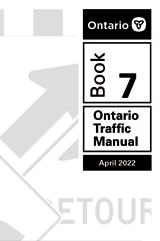




ADVERTISING SALES REPRESENTATIVE Patricia Abbas 416.438.7609 pabbas8@gmail.com EDITOR Lara Henry larahenry@sympatico.ca DESIGN & EDITORIAL LAYOUT pdplante.com pdominiqueplante@gmail.com COVER PHOTO Ottawa. (©iStock) © 2022 All Rights Reserved. MESSAGE FROM THE CHIEF EXECUTIVE OFFICER 6 AROUND QUEEN’S PARK 10 OPIOID ADDICTION: AN INDUSTRY PRIORITY 12 THE 4 STAGES OF A SUBSTANCE-USE DISORDER 18 BOOK 7 UPDATED 22 INDUSTRY PRIORITIES FOR ONTARIO ELECTION 26 ANNUAL MEMBERS’ GOLF TOURNAMENT 32 LIFELONG LEARNING & THE ROAD BUILDING ACADEMY 35 NEW WORKPLACE SAFETY LAWS 38 INFLATION IN THE HEAVY CIVIL 40 CONSTRUCTION INDUSTRY ORBA OPINION 42 ORBA CORNER 46 NEW MEMBERS 48 LIST OF ADVERTISERS 50 TABLE OF CONTENTS 40 26 18 FALL 2022 5 12 22
The official publication of ROADBuilder is published biannually by the Ontario Road Builders’ Association Publications Mail Agreement #40011181 Return undeliverable items to: The Ontario Road Builders’ Association 365 Brunel Road, Unit 1 Mississauga, ON
Chief Executive Officer BRYAN HOCKING

The ORBA office has been quite the hive of activity this summer. We are feeling pre-pandemic vibes, and those feelings kicked off with the development and delivery of our comprehensive provincial election campaign. The campaign centered around the ORBA 2022 Provincial Election Priorities document that was made available to all provincial parties and the general public to inform them of the road-building industry’s priorities. The summer also brought back in-person events like the Annual Members’ Golf Tournament, an event that had not been held since 2019, and the OAPC Asphalt Technical Symposium. On the education front, we held webinars on Closing the Labour Gap, Battling Fuel Costs with PTO Refunds, and Naloxone and Managing Opioid Overdoses.
In the short paragraph above, I hit on three benefits that the association provides to all members — Advocacy, Events, and Education. If you add the fact that you’re reading this publication, we can add a fourth — Communications.
Advocacy is at the heart of what ORBA does for its members. Our advocacy team meets regularly with the transportation minister’s office and ministry senior staff
Message from the Chief Executive Officer
on a variety of policy issues at the direction of our members. These strong working relationships ensure ORBA has regular updates on MTO pipeline transparency, capital projections, and upcoming regulatory changes.
Additionally, ORBA works with its partner associations on collective issues to apply pressure and maintain a larger network of construction association allies.
As a member, you can help shape policy by joining one of ORBA or OAPC’s committees or working groups. Committee members are dedicated volunteers who contribute their time and expertise for the betterment of the road building industry.
We can’t forget about the ORBA Road Building Academy. The Academy is a week filled with select courses tailored to the road-building industry. Areas of study include management and leadership, business and professional topics, technical and safety issues, and law and legal matters. The 2023 Road Building Academy will run from February 27 to March 3, 2023, with registration beginning in September 2022. Furthermore, ORBA has partnered with BuildForce Canada to offer an array of online courses developed for the construction industry. To learn more about this offering, please visit www.orba.org/onlinecourses.
The SOURCEBOOK is another member bonus. The association’s annual industry directory is a hard copy contact resource for ORBA members that includes a
››
6 ORBA | ROADBUILDER

comprehensive list of contractors, producers, asphalt cement suppliers and associate members, and government agencies and associations. Recently, we sent out an email asking all our members to update their company profile as we are currently working on publishing the 2023 SOURCEBOOK. If you haven’t updated your company profile, please check your inbox for your personal email, or contact the MarCom team at MarCom@ orba.org on how we can help you.

ORBA’s communication channels give members insider knowledge into the transportation infrastructure industry with our two self-published magazines, RoadBuilder and ASPHALTopics. RoadBuilder is published twice a year and focuses on the latest advocacy news, current trends in the road-building industry, association events, industry issues, and legislative changes. ASPHALTopics is published three times a year with each issue covering the latest technological innovations and projects, company profiles, industry news and views. Members also receive bulletins, e-Blasts, and Information Highway, ORBA’s e-Newsletter.
The ORBA and OAPC websites are a prime means of communicating with members, and provide a members-only corner that offers materials, like recordings of past webinars, reports, videos and presentations, as well as special member
offers. I’m excited to say that both websites are currently being redesigned and will be ready by mid-February 2023.
Another member perk is the ORBAdvantage Program which promises to take your savings to the next level. Members have access to exclusive discounts on a number of professional services. Please visit www.orba.org/advantage to sign up and start saving now!
In November, we’ll be hitting the road with the President’s Tour, one of our members’ most popular events. The President’s Tour provides us with the ideal opportunity to connect with members and stakeholder partners like MTO and local municipal representatives in an intimate and interactive setting. The tour starts in Sudbury on November 8, continues in Ottawa on the 10th, Toronto on the 15th and wraps up on the 17th in London.
Rounding out the rest of the year, member-only events include the Fall Gala, with a Roaring 20s theme on October 15, the Easter Seals Celebrity Hockey Classics Series on November 3 and 4, the OAPC Fall Asphalt Seminar on December 1, and to start off the New Year, the ORBA Annual Convention and AGM on February 6 and 7, 2023.
It’s true what they say — membership truly has its privileges.
8 ORBA | ROADBUILDER
 Director, Policy and Stakeholder Relations
ANDREW HURD
Director, Policy and Stakeholder Relations
ANDREW HURD
Summer has come to a close, vacations are a memory and the kids are back to school for another year. The fall has always given me a charge of energy as we sprint to the end of the year. The Policy and Stakeholder Relations Division at ORBA has a full agenda and we are prepared to work on your industry priorities with the newly elected provincial government.
Bill 2: Ontario’s Plan to Build Act
Following the Progressive Conservatives’ commanding victory in the provincial election, Premier Ford’s government promptly reintroduced the budget originally tabled on April 28 as they had pledged during the campaign. There has correspondingly been no change in the $3 billion global highways budget for this year, with expansion and rehabilitation remaining at just over $2.3 billion. This is all part of a strong highways program of $25 billion over the next ten years. MTO has released several comprehensive regional transportation plans to date,
Around Queen’s Park
and transit funding of just over $8 billion this year, together with the highways funding, reflects these important initiatives to Keep Ontario Moving. I’m pleased to see evidence of a strong first fiscal quarter in the MTO highway spend, with our tracking indicating over $870 million awarded to date at the time of writing.
The budget also prominently features crucial ORBA-supported projects such as Highway 413 and the Bradford Bypass. In our election priorities document, ongoing media spots, and social media presence, we have and will continue to emphasize the necessity of these projects being built. There is sometimes a tendency to look at these projects in isolation. Simply put, it’s a tall order for any single major project to fix regional congestion issues, estimated to cost Ontario’s economy $11 billion in the GTA alone. That’s why ORBA is supportive of the government’s ongoing commitment to ensuring these vital projects move forward, together with the highway infrastructure and new transit outlined in the Government’s Greater Golden Horseshoe Transportation Plan. Highway 413 and the Bradford Bypass are key pillars which will help ensure the safe and efficient movement of goods and people across our communities.
Reducing risk and creating value for Ontarians
A key component of ORBA’s priority list going forward is the creation of a price index for key materials on all public contracts. MTO’s fuel and asphalt cement indices are important elements in reducing risk for both contractors

10 ORBA | ROADBUILDER
and public owners, helping to create the best possible value for Ontario’s infrastructure dollars. However, there is no mechanism to deal with the heightened inflation of other important construction materials. ORBA continues to have important discussions with MTO on potential indices for materials such as steel, as well as encouraging the use of these indices by municipalities.

Association of Municipalities of Ontario (AMO) conference

I was pleased to represent ORBA alongside three of my colleagues at the annual AMO conference which took place in Ottawa in August. The ORBA/ OAPC booth was well-situated near the entrance to the main plenary sessions, providing a great opportunity for friendly dialogue with municipal and provincial representatives. Many discussions were had regarding issues such as recycled asphalt pavement (RAP), materials indices, the construction labour shortage, and the need for a provision prohibiting drivers from overtaking snow plows. As always, our ORBA/OAPC “swag” was a big hit on the trade show floor.
As the air turns a little colder, we will be keeping ourselves warm out on the hustings at Queen’s Park, meeting with new and returning MPPs, and continuing to harness the expertise of our members on priority topics, including capital pipeline integrity, worker safety, indexing, the construction labour shortage, and the responsible reuse of non-renewable construction materials. Your knowledge and engagement is essential in powering ORBA forward.
FALL 2022 11
Opioid addiction:
An industry priority
It’s difficult to downplay the risks of opioid addiction in construction. At last count, sector workers accounted for the lion’s share of opioid-related deaths in Ontario alone, and the numbers are equally concerning across Canada. It’s a worker health and safety issue with immense implications, but one that can be combated with greater awareness, empathy, and proven prevention measures.

12 ORBA | ROADBUILDER
©iStock
Canadians died of opioid toxicity deaths in 2021, approximately 21 deaths per day1 .
Addressing opioid addiction begins with acknowledging the threat. And indeed, a report from Public Health Ontario (PHO) frames the issue in no uncertain terms, indicating that one out of thirteen opioid deaths between 2018 and 2020 occurred among individuals in the construction industry, totaling 366 lives lost. Moreover, the PHO’s research states that over half of these victims were employed at their time of death and that 90 per cent of incidents were directly related to the use of nonpharmaceutical opioids (e.g. fentanyl).
“It’s a public health crisis we can’t ignore,” says Mark Barnes, pharmacist and owner with Respect Rx Pharmacies and NaloxoneCare.com. “This isn’t a new crisis either; we’ve seen the problem of opioid addiction take shape for years. And right now we know that one-third of all individuals employed at the time of their overdose were employed in the construction industry.”
Understanding the physical and mental drivers
Opioid addiction is a public health issue prone to stereotypes and misconceptions. While statistics from the government of Canada point to middle-aged males as the demographic most likely to be affected, individuals of every age and background are susceptible.
If there is a common thread between opioid-related deaths and hospitalizations in Canada, it’s that a majority of the affected individuals began taking the drug in response to physical or mental trauma in their lives. In the construction sector specifically, PHO reports that 78 per cent of workers who lost their lives to an opioid overdose had an injury or pain diagnosis in the five years leading up to their incident (nearly a quarter within one week prior), while 82 per cent had seen a healthcare professional for a mental health issue over the same period.
“This is a very multifaceted issue involving a lot of moving parts,” says Lauren Poel, a mental health and addictions professional and author of this issue of RoadBuilder ’s deep dive into addiction. “For one, we know that this industry is hard on the body, not to mention the aging body. Therefore, a lot of substance use results from past or present injuries. However, it is also important to look at the mental health issues that can arise in the industry as well.”
There are no shortage of mental health factors to consider. As anyone in the field can attest, construction workers can find themselves working long and
1 https://health-infobase.canada.ca/substance-related-harms/opioids-stimulants/
››
FALL 2022 13
29,052
Between 2018 and 2020,
1 out of 13 opioid deaths occurred among individuals in the construction industry.
irregular hours in risky, remote, or uncomfortable environments. Some are also likely to feel “stuck” and bored in their positions, while others may live under the constant stress of not knowing when they might be laid off.
“Construction is an industry where a high number of people, for one reason or another, live paycheque to paycheque and feel that they can’t afford to take a day off,” says John Savoia, Director of Health and Safety, Powell Road Safety Group. “Trends show that even with injuries sustained at home or outside of working hours, or illnesses, workers still feel the need to come into work because they can’t afford not to, which is an issue in and of itself that employers may sometimes face.”
3,000
people in Ontario are expected to die from opioid toxicity deaths yearly for the next five years.
rather injured workers take care of themselves before returning to work, employees may want to avoid looking “weak” or less dedicated than their peers. “And that kind of attitude becomes problematic when trying to deal with such a large issue like addiction and mental health,” adds Poel.
and engaging in activities which could have an effect on their performance and ability to work the next day such as using opioids, but there’s not a lot of instances where workers are coming to work showing clear cut signs of addiction at work, if any.”
James Stracey, Vice President of Emcon Services Inc.’s Ontario Division, agrees that opioid addiction issues are few and very far between in his corner of the industry, “I’ve seen very little within the highway maintenance industry.”
“People can mask their addictions very well,” Savoia adds. “It can be hard to recognize.” Visible or not, both Stracey and Savoia agree that the issue remains one that needs to be on all companies’ radars, even if it might not manifest on the jobsite itself.
Support, not shame
An invisible threat
These attitudes and jobsite stressors can add up and contribute to a higher risk of developing a substance use disorder, especially among those who are already struggling with a mental health disorder or genetically predisposed to develop an addiction.
It also doesn’t help that the “work hard, play hard” mentality lingers in the construction industry. Even when employers make it clear that they’d
Understanding where opioid-related deaths occur adds further insight for industry stakeholders. To that end, PHO research2 reveals that that a majority of deaths (79 per cent) occurred in a private residence, while less than 2 per cent actually occurred at the jobsite or a motel/hotel used for work purposes. More worrying still is that statistics indicate many of those who do die at home do not have an individual present to intervene.
“Opioid addiction isn’t something we see typically during working hours,” notes Savoia. “That’s not to say that people aren’t going home after work

2 https://www.publichealthontario.ca/en/Data-and-Analysis/Substance-Use/Opioid-Mortality 3 https://www.ola.org/en/legislative-business/bills/parliament-42/session-2/bill-88
The fact that many opioid-related deaths in construction are linked to physical or mental trauma is no small insight. It is a clear call that more needs to be done to create a culture where conversations are open and non-judgmental so that people are not afraid of losing their employment. “We have to stop judging why people use substances in the first place and address where that pain is coming from.”
Certainly, there is a need to address the attitudes and stereotypes that may prevent workers from talking openly about their physical and mental health issues. The key is dismantling the idea that “working through the pain” is the sign of a good worker, or that staying silent when hurt is the way of the business.
14 ORBA | ROADBUILDER
©iStock
In addition to creating an environment where employees can speak openly about the issues that may lead them to opioids, there is a need to create greater training and awareness around spotting addictions when they take shape.
“Continual training is the key, especially when it comes to encouraging employees to be open about any potential issues that they may have encountered,” says Stracey. “Remember, too, construction is still a very male-oriented industry, and there are men who aren’t very good about talking about their problems. So we have to recognize that, too.”

Poel also advocates for more industry education on the topics of mental health and addiction, particularly in regards to helping employers recognize opioid addiction and respond if an overdose occurs on the job. “Knowledge is
power,” she says. “And as we all know, the industry is in desperate need of workers, meaning companies need the employees they do have to stay healthy and thriving.”
Enter Bill 88
Responding to opioid addiction in construction is a responsibility shared by all stakeholders. Even still, incoming changes to Bill 88, Working for Workers Act, 20223 , aim to shift a bulk of the liability to employers.
Specifically, the Occupational Health and Safety Act is amended by adding section 25.2 which states:
(1) Where an employer becomes aware, or ought reasonably to be aware, that there may be a risk of a worker having an opioid overdose at a workplace where that worker performs work for the employer, or where the prescribed
circumstances exist, the employer shall, (a) provide and maintain in good condition a naloxone kit in that workplace; and (b) comply with any other prescribed requirements respecting the provision and maintenance of naloxone kits and the training referred to in subsection (3). ››
FALL 2022 15
In 2021, 88%
of all accidental apparent opioid toxicity deaths occurred in British Columbia, Alberta, or Ontario.
The amendment goes on to say that the training mentioned above should cover “how to recognize an opioid overdose, how to administer naloxone, and hazards related to administering naloxone.”
While the amendments bring greater attention to the issue of opioid addiction in the industry, there are concerns that Bill 88 may place a disproportionate amount of responsibility on employers’ shoulders. “The contractors or employees have been put on the front line of a critical public health issue, even though many of us aren’t really trained on how to deal with it,” says Stracey. “It feels like the ball has been passed to contractors.”

Bill 88 may be drafted with good intent, but some argue that more clarification and direction are needed if employers are expected to bear the brunt of its execution, or face heavy fines in the event they cannot. Specifically, says Savoia, “People can hide an addiction with the best of them, so the part of the act that says employers ‘ought reasonably to be aware’ isn’t a great descriptor. I know I can’t always look at someone and say, ‘Oh, this person is clearly grappling with a drug problem,’ because there could be other things going on, and I don’t want to make assumptions.”
There are also concerns that Bill 88 does not offer clear direction or standards regarding the type of training needed to conform to the amendments. Additionally, the introduction of exponentially higher fines for employers who do not meet these standards has employers calling for more guidance and support ahead of the new rules.
4 https://www.wsps.ca/resource-hub/articles/7-things-to-knowahead-of-the-new-naloxone-kit-requirement
There’s a reason Bill 88 focuses on placing naloxone kits (aka Narcan) on the jobsite. As an overdose prevention tool, it’s imperative that naloxone kits are easily accessible where workers are present, and that everyone is trained in their use.
How does nalaxone work?
Naloxone is an opiate antagonist that reverses an overdose and keeps individuals breathing until paramedics arrive. Delivered via nasal spray, it works by going into the receptors and removing the opioid-off receptors that then reactivate the breathing.
Is it safe?
“It’s completely safe,” stresses Barnes. “Even if you’re wrong and the person didn’t need it, you’ll do no harm. It’s the safest and easiest thing you can give someone having an overdose, so why wouldn’t you?”
How should it be
stored?
According to Workplace Safety and Prevention Services (WSPS) 4 , “The kit must be in close proximity to the person who will administer it, and easily accessible. The logical place to store the naloxone kit is in your first aid kit or close to your automated external defibrillator (AED).”
How much does it cost?
Naloxone kits can be picked up for free from a pharmacy through the Good Samaritan Drug Overdose Act. Moreover, the Ontario government is in the midst of developing a program that provides free naloxone kits and training to employers.
Find free naloxone kits and training at: www.ontario.ca/page/where-getfree-naloxone-kit
16 ORBA | ROADBUILDER
These and other issues regarding Bill 88 were recently addressed in a joint statement provided to Monte McNaughton, Minister of Labour, Training and Skills Development, by ORBA and several industry partners in March 2022.
“As Ontario’s economy is still on the road to recovery, new regulations which directly impact business operations should be done so prudently and meticulously. Bill 88 provides the government a unique opportunity to strengthen workplace health and safety while avoiding placing unreasonable risk on the business community,” it reads.
Yet, despite the gaps, there is a general consensus that Bill 88 is a step in the right direction. Moreover, Barnes is confident that the clarity the industry seeks will come down from Queen’s Park as the Bill gets closer to becoming
a reality. Overall, he says, “It’s a fantastic initiative. To have a non-health minister lead a Bill that says he wants to make sure our employers come to work safe and stay safe is a great thing to see.”
Fit for duty
Bill 88 or not, there’s no arguing that employers have a degree of responsibility when it comes to addressing the opioid issue. Promisingly, many in road building and across the industry are already taking the obligation to heart, embedding opioid addiction training within their health and safety programs and making naloxone kits available within their sites.
“It all comes down to having a system in place where ‘fit for duty’ is at the top of every supervisor’s mind each and every day or night, and they are trained to recognize the signs that would indicate one of their workers is unfit for duty,”
says Savoia. “Honestly, that’s the best thing that a company could do — have policies, procedures, and protocols in place to make sure the people on site are fit to be there. And if they’re not, that we ensure work is stopped, an investigation is undertaken, and the individual gets home safe and gets the support they need.”
Opioid addiction has taken root in construction. Tackling the issue requires a united effort among all stakeholders to address the root causes, respond effectively to overdoses, and provide workers with the training and support they need to avoid becoming another statistic.
Matt Bradford is an industry writer for the Canadian construction industry. He can be reached at mirbradford@gmail.com.

FALL 2022 17
a person struggling with an addiction: colleagues, parents, friends, siblings or even yourself. The American Society of Addiction Medicine defines addiction as “a treatable, chronic medical disease involving complex interactions among brain circuits, genetics, the environment, and an individual’s life experiences.” Clinically, the term addiction is used synonymously with a SUD (Substance-Use Disorder).

18 ORBA | ROADBUILDER
©iStock
Addiction
The four stages of a substance-use disorder
imilar to cancer or heart disease, addiction is chronic and can be managed, but is never cured. I have worked in the addiction and mental health field for over 10 years and have encountered many different types of clients. I have come to learn that addiction is a process that occurs over a long period of time and is often aided by several circumstances, some of which involve trauma.
To understand this process more clearly, my previous client Marco is a good example of how addiction slowly evolves from innocent experimentation to a full-blown substance use disorder.
Born in Windsor, Ontario, to two loving, hard-working parents, Marco would describe his childhood as a happy upbringing. He was an astute adolescent who enjoyed hanging out with friends and drinking alcohol. A spark would appear in Marco’s eye as he

spoke about drinking; he would often say “it’s something I’m good at.” For Marco, it boosted his energy level, gave him a clear mind and the confidence he needed. He would say: “Lauren, some people are good at soccer or hockey — I can drink.” And drink he did! Marco closed the bars each night and was always referred to as a “happy drunk.”
On a deeper level, Marco felt something inside him was missing; an empty void. He tried to fill this void with romantic relationships, material goods and work, until the death of his father in 2000 — his tipping point. Marco’s father died from alcoholism, as did his grandfather. Marco’s predisposition genetically, as well as his early substance use, were additional precursors that made it much more difficult for him to cope with his trauma.
Trauma plays a large role in fueling addiction. In today’s society, the word
“trauma” is often misunderstood as being a catastrophic event. However, trauma is any type of distressing event or set of experiences impacting a person’s ability to cope and function. Specific to addiction, trauma and addiction are a two-way street. Trauma increases the risk of an individual to have an addiction, while the substance use increases the likelihood of being re-traumatized by engaging in high-risk behaviours. As Marco walked through life, things became more complex — the trauma from bullying at school to the death of his father — making it even more difficult for him to cope in a healthy way.
The road to addiction is different for every person. Some people take their time while others go from 0 to 60 in a short period of time. No matter how long the journey is, most counselors agree that there are four main ››
FALL 2022 19
S
·
·
EXPERIMENTATION
REGULAR USE · HIGH-RISK USE · DEPENDENCY

stages of a substance-use disorder: experimentation, regular use, risky use/abuse, and finally addiction/ dependency. It’s important to note that not all individuals within the first two stages of this process will develop an addiction, but individuals within the third stage are extremely likely to develop a substance dependency. Here’s a closer look at the stages: Experimentation is characterized by the voluntary use of substances for exploration, enjoyment and fun. For many, experimenting may occur once or several times as a way to “have fun.”
For Marco, this stage began when he was quite young, stealing vodka from his parent’s liquor cabinet.
Some people will then enter the stage of Regular Use without developing a dependence or addiction. This is characterized by regularly engaging in substances with no negative social or legal consequences. For Marco, he was drinking alcohol to have confidence and to socially connect with his friends.
The line between Regular Use and High-Risk Use is a thin one, but it is usually defined as the continued use of substances in spite of severe social and legal consequences. What might have begun as a temporary form of escapism can quickly lead to more serious problems. This is the stage where the warning signs of addiction will begin to appear: craving, preoccupation with the drug, and symptoms of depression, irritability and fatigue if the substance is not used.

The final stage of an addiction is Dependency. Some characteristics include withdrawal symptoms and the compulsive use of the substance, despite severe negative consequences to his or her relationships, physical and mental health, personal finances, job security and criminal record. For Marco, he was barely functioning, stealing to support his addiction, living out of his car and feeling an overwhelming sense of shame and guilt.
It is important to understand that almost everyone will fit into one of these stages, whether it be with alcohol, smoking, sex, gambling, or drugs.
It’s been in my experience that a lot of individuals will seek recovery due to precipitating factors such as medical issues (such as the body shutting down), legal issues, failing relationships etc. You may recognize the phrase “hitting rock bottom.” This indicates a person’s hopelessness, cry for help and sheer desire to live. Marco was ready to end his life and longed for happy connections with others. It was not until he saw a recovery group flyer that he contemplated the idea of recovery.
For many individuals, the first step to recovery is acknowledging their personal struggle with the substance and understanding that recovery is not a linear process. This process ebbs and flows and for some individuals they will relapse many times before they are able to maintain life-long sobriety. It is something that takes a lot of time, sheer willpower and self-discipline to achieve and maintain.
As our understanding of addiction, both scientific and theoretical, continues to grow, effective treatment models have been developed for those choosing to seek help and begin their recovery process. For example, some people with severe forms of addiction enter
a detox program before transitioning into a rehabilitation program. For others, they may choose an outpatient facility offering evening programming, or attending a support group such as AA, NA, CA, etc. The key is to start speaking about it with people who can be trusted and to not hide or deny use. Addiction breeds on deceit.
No one wants to become dependent on substances. It is an issue that is extremely complex and is always a cry for help. Addiction needs to be approached in a non-judgemental, accepting way that accounts for each individual’s process. Marco has been in recovery for over 15 years; it was not until he became accountable for his actions that he saw success.
Lauren Poel is a mental health and addictions professional who has over 10 years of experience in the field.
FALL 2022 21
Addiction is an issue that is extremely complex and is always a cry for help.
BOOK UPDATED 7
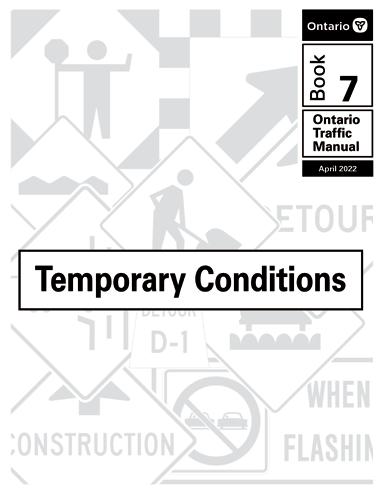


22 ORBA | ROADBUILDER
©iStock
OTM Book 7 provides fundamental principles, guidelines, and current best practices for traffic control in temporary work zones with the goal of ensuring the protection of workers and the safe and efficient movement of highway users through work zones.

The 2022 edition of OTM Book 7 is an update to the January 2014 edition. “This edition of Book 7 is better laid out and more user-friendly and easier to read with a more logical layout. The placement of related subjects, table locations, and the general look of things is much improved and more in line with similar guidelines from other jurisdictions,” says Peter Wehmeyer, president of Direct Traffic Management Inc.
Since that January 2014 edition, there have been significant developments in Ontario regarding traffic management. New content in the 2022 version includes:
• A new chapter on the transportation management planning process;
• A graphic table of contents for traffic control devices;
• A revised format and style with simpler language;
• Layouts for roundabouts, pedestrians, cycling facilities and HOV lanes;
• The inclusion of relevant information from the Temporary Conditions Traffic Management (TCTM) manual;
• Linear space restrictions.
“This edition is much larger to accommodate the many updates and some much needed and relevant changes including the number of typical layouts, which are now just called layouts. Book 7 is considered a set of guidelines and the layouts are to be adapted when planning and implementing the work, but the old version did not address many situations that have changed significantly in the years since the old version such as the addition of bike lanes and HOV lanes,” says Wehmeyer. Layouts have new layout numbers and are reorganized based on facility type such as intersection, roundabout, freeway, etc. A new Table F has outlines for nomenclature of layouts organized based on facility type – two-lane, two-way; multilane undivided; multi-lane divided; and freeway. It is also colour coded for easier finding. There are new cyclist, pedestrian and roundabout layouts, and the field edition has been revised for
clarity and readability with a new, larger document size. Each layout includes a table specific to the labels shown in that layout, and notes specific to the layout are also provided.
Other updates to this edition include:
• Automated Flagger Assistance Devices (AFADs) and the distinction of regulatory requirements versus guidelines for use;
• The implementation of longer tapers to help traffic safely manoeuvre through temporary work zones;
• The addition of a layout table to help users determine the most appropriate table to use within their traffic management plan; ››
The Ministry of Transportation Ontario (MTO) has published an updated edition of Book 7 - Temporary Conditions (office and field edition). Book 7 is one of a series of volumes that makes up MTO’s Ontario Traffic Manual (OTM). The purpose of the Ontario Traffic Manual is to provide detailed information and clear guidance for transportation professionals to promote uniformity in the design, application and operation of traffic control devices and systems across Ontario.
FALL 2022 23
• A new 110 km/h regular posted speed added to tables;
• Accommodation for cyclists consistent with the new OTM Book 18;
• Training (Section 1.3);
• Sign reflectivity – Type I signs changed to Type III/IV;
• Decision matrices for regulating traffic;

• Queue end warning;
• Unplanned events layouts.
“One of the biggest changes for people using this book is the taper length — the part of the closure that moves traffic over and diverts it away from the work area. The new standard reflects the best practices from all over the world and the highest safety standard for workers and drivers alike. Many taper lengths are significantly longer, but the size is relative to the posted speed limit of the roadway which is the correct way to calculate that distance,” says Wehmeyer

A significant addition to the revised Book 7 is the inclusion of guidelines and regulations for the use of AFADs to supplement a Traffic Control Person (TCP). AFADs are consistent with the objectives of the Moving Ontarians More Safely Act, 2021
(MOMS) to improve road safety and protect vulnerable road users. AFADs may be used only be used as a supplement for a TCP to control traffic on two-lane, two-way highways reduced to one lane for intermittent, very short or short duration work. AFADs may not be left unattended by a TCP while operational and they must be stationed close enough to allow them immediate access to display a stop/slow paddle should the AFAD malfunction.
The revised Book 7 shows the type, design and specifications for AFADs signage and the AFAD signal itself which must also include a moveable gate arm. There is a distinction between the regulatory requirements and the guidelines for use.
The guide also includes updates on the use of positive protection devices to prevent the intrusion of motorized vehicles into the workspace and other hazardous areas of the work zone. These include buffer vehicles and truck mounted attenuator (TMA) requirements. An attenuator is an energyabsorbing device mounted onto the rear of a truck or trailer, which will deform upon impact in a controlled manner.
“It is great to see that new buffer vehicle TMAs (replacements and new purchases) must be up-to-date to meet the AASHTO
24 ORBA | ROADBUILDER
Lane Closed (Automated Flagger Assistance Device)
Bicycle Lane Diversion: Bicycle Lane Shift
Manual for Assessing Safety Hardware (MASH) TL-3 requirements. This is an important improvement in safety for workers and drivers in workzones and brings Ontario in line with the leading safety-focused jurisdictions in North America,” says James Delamere, president of Stinson Owl LIte. “The team incorporated many of the suggestions from our group sessions around the province with stakeholders and worked hard to make it the best possible guideline for the province to use moving forward,” says Wehmeyer. “I applaud the province and the Ministry of Transportation for taking a big step with this book. It was a bold move to make such dramatic changes, but it was much needed. Now we have a better foundation for future versions of Book 7 to work from and a better set of standards for safer roads across the province.”

All OTMs can be downloaded from the MTO library site or from Publications Ontario. Hard copies of the OTM Book 7 office and field editions will also be available to purchase from Publications Ontario.
 Lara Henry is a communication specialist and editor of ROADBuilder.
Lara Henry is a communication specialist and editor of ROADBuilder.
FALL 2022 25
Roundabout: Outside Lane Closed
ORBA’s policy and communications one-two punch gets industry priorities out in front of party leaders and voters
The 2022 provincial election had Ontarians putting party leaders’ feet to the fire to listen to their concerns. The Ontario Road Builders’ Association had its own priorities and outlined them in a document called Keep Ontario Moving: ORBA’s 2022 Provincial Election Priorities.

26 ORBA | ROADBUILDER
KEEP ONTARIO MOVING
The plan set out ORBA’s top five priorities which were:
1. Creating a price index for key construction materials; 2. Reducing risk and creating value for Ontarians; 3. Addressing the shortage of heavy civil construction labour; 4. Sustainable transportation infrastructure projects; and 5. Enhancing safety for all road users.
ORBA’s first priority called for sustained or increased highways and transit capital funding.
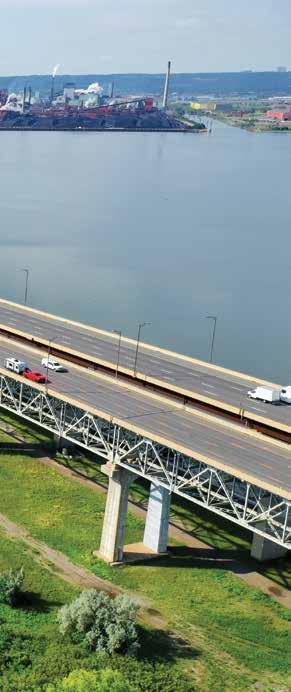
“Infrastructure such as Highway 413 and the Bradford Bypass needs to be built as part of a multi-modal strategy to keep Ontario moving,” says Bryan Hocking, Chief Executive Officer of ORBA. “Congestion costs us all. Time spent in traffic keeps us away from spending time with family and friends and costs Ontario’s economy $11 billion in lost productivity in the GTA alone.”
The association’s second priority was the creation of a price index for key construction materials on all public contracts. ORBA also pushed government to work with the industry to bring further clarity to essential project material specifications.
Infrastructure such as Highway 413 and the Bradford Bypass needs to be built as part of a multi-modal strategy to keep Ontario moving.
BRYAN HOCKING
“Currently, Ontario does not have a mechanism to deal with the hyperinflation of construction materials such as steel, lumber and ready-mix concrete,” says Andrew Hurd, Director, Policy & Stakeholder Relations at ORBA. “Price uncertainty for these important construction materials increases risk for both contractors and public owners, creating unnecessary volatility in the procurement process. More price certainty creates the best possible value for Ontario’s infrastructure dollars.”
As a designated essential service during the COVID-19 pandemic, the roadbuilding industry worked tirelessly to deliver important transportation infrastructure projects while keeping its workforce safe. Compensation has been provided for additional personal protective equipment (PPE); however, the upfront costs of many other safety measures that affected productivity have not been recovered. ORBA called for a mechanism on all provincial contracts that would provide coverage and compensation for pandemicrelated impacts.
Ontario faces a growing shortage of skilled workers, and recent projections indicate that the industry will require tens of thousands of new workers, including skilled labour and apprenticeship and non-apprenticeship trades over the next decade. ORBA’s third priority called on the provincial government
››
FALL 2022 27
Congestion already costs the GTA
$11 billion per year in lost productivity and creates carbon emissions.
to work with their federal partners on a more robust immigration strategy to attract more heavy civil construction workers to Ontario.
“Current provincial and federal programs, such as the Ontario Immigrant Nominee Program (OINP) and the federal Express Entry programs, are unable to deal with the current labour shortage challenge,” says Hocking. “An immigration strategy that recognizes the unique workforce requirements of the transportation infrastructure industry is a crucial step to keeping up with the growing needs of Ontario.”
“ORBA wants more provincial government promotion and recognition of the nonapprenticeship skilled trades,” says Hurd. “The building of essential transportation
infrastructure requires a multi-skilled workforce with many essential nonapprenticeship type jobs and mentoring opportunities that remain unfilled. It is imperative that government works with industry to promote these opportunities and challenge the perceived stigma around careers in construction.”
ORBA’s fourth priority called on the province to promote the responsible reuse of non-renewable construction materials on more transportation infrastructure projects.
“Our industry has demonstrated a clear commitment to a circular economy through the use of recycled construction materials such as reclaimed asphalt pavement and aggregate. Together with governments, we can do more,” says Hocking. “As proud Ontarians and responsible industry leaders, we want to continue to deliver the highest quality projects in the most sustainable way.”
Lastly, ORBA called for a provision that would prohibit drivers from overtaking snowplows working on provincial highways.
“When a collision involves a snowplow, it doesn’t just affect the drivers and vehicles involved, it interrupts the vital safety function that the snowplow was providing and potentially makes driving in winter conditions more dangerous,” says Hurd. “A provision under the Highway Traffic Act is needed to guard against these dangerous incidents, keeping traffic and trade moving and enhancing the safety of the travelling public.”
To get their priorities in front of all parties, ORBA’s Policy and Communication’s team developed a joint strategy to amplify their message and get it out to as many candidates and voters alike. The strategy included a media release of the Keep Ontario Moving: ORBA’s 2022 Provincial Election Priorities document, media interviews, a social media campaign, a candidate survey on the road-building industry, opinion pieces

28 ORBA | ROADBUILDER
and a letter-writing campaign to all new and returning MPPs.
The media release was picked up by 37 media outlets and a reached a potential audience of 2.5 million including Yahoo Finance Canada, the Canadian Business Journal, Daily Commercial News (one article on priorities and a separate piece featuring an interview with ORBA CEO Bryan Hocking), On-Site Magazine, Construction Links Network, ReNew Canada, Canadian Industry Online, and Ontario Construction News.
The social media campaign ran on LinkedIn and Twitter from May 10 to June 3. Several postings per day highlighted the association’s priorities. Posts were accompanied with graphics and tagged with key individuals, parties, and shared hashtags. The campaign was a success with 160,000 impressions and 55,000 unique individual reach.
The policy team conducted a nonpartisan platform comparison of the four major political parties based on important election issues that pertain to the road-building industry, and published their findings as the Ontario 2022 Election Platform Comparison, on ORBA’s website. The document garnered 6,000 unique views in just ten days. To put this in perspective, a typical post on ORBA’s website typically receives 1,200 in a month. The Ontario 2022 Election Platform Comparison was also published as an opinion piece in 30 Metroland newspapers across the province that included Thestar.com, the Hamilton Spectator, the London Free Press , and the Vaughan Citizen . The opinion piece reached a potential audience of 10.2 million readers.
On August 9, the Ontario government officially opened the new legislative session with the throne speech and the reintroduction of the Ontario 2022 Budget: Plan to Build Act (Budget Measures). The speech from the throne highlighted priorities such as red-tape reduction, transit and transportation
infrastructure, the Ring of Fire, and the labour shortage in the skilled trades, while also accounting for current economic uncertainty characterized by COVID-19, high unemployment and inflation.
The reintroduced budget projects $185.2 billion in expenditures this year and a deficit totaling $18.8 billion (down from $19.9 billion, as previously stated). Much of the budget remains the same since it was first introduced back in April. Here is a recap of the major transportation highlights: ››

SUMMER 2022 29
Provincial highway program
• $25.1 billion over the next 10 years to support the construction and planning of highway expansion and rehabilitation projects across the province.
• $3 billion in funding for provincial highways in 2022-23.
• Moving forward with several key highway projects including Hwy 413, Bradford Bypass, and Hwy 401 expansion through Oshawa and Port Hope, Pickering and Eastern Ontario (Belleville to Brockville).
• QEW Garden City Skyway Rehabilitation Project.
• Hwy 7 from Kitchener-Waterloo to Guelph.
• Various expansion projects including: Hwy 6 in Hamilton, Hwy 17 from Arnprior to Renfrew, and Hwy. 3 from Essex to Leamington.

• $492.7 million in 2022-23 for highway projects in Northern Ontario including twinning of Hwy 17 from Kenora to the Manitoba border, expansion of Hwy 69 in the French River area, reconstruction of Hwy 101 through Timmins, and expansion of Hwy 11/17 between Thunder Bay and Nipigon.
• $1 billion for critical infrastructure in the Ring of Fire.
Post election, letters of congratulations were sent out to all 124 members of provincial parliament (MPP) introducing ORBA and a request to meet with key MPPs, the Minister of Transportation and high-level ministers on specific issues.
To learn more about ORBA’s transportation plan, visit the ORBA website at www.orba.org, or click on the link to read Keep Ontario Moving: ORBA’s 2022 Provincial Election Priorities.
John Provenzano is the director of marketing and communications for ORBA.
30 ORBA | ROADBUILDER
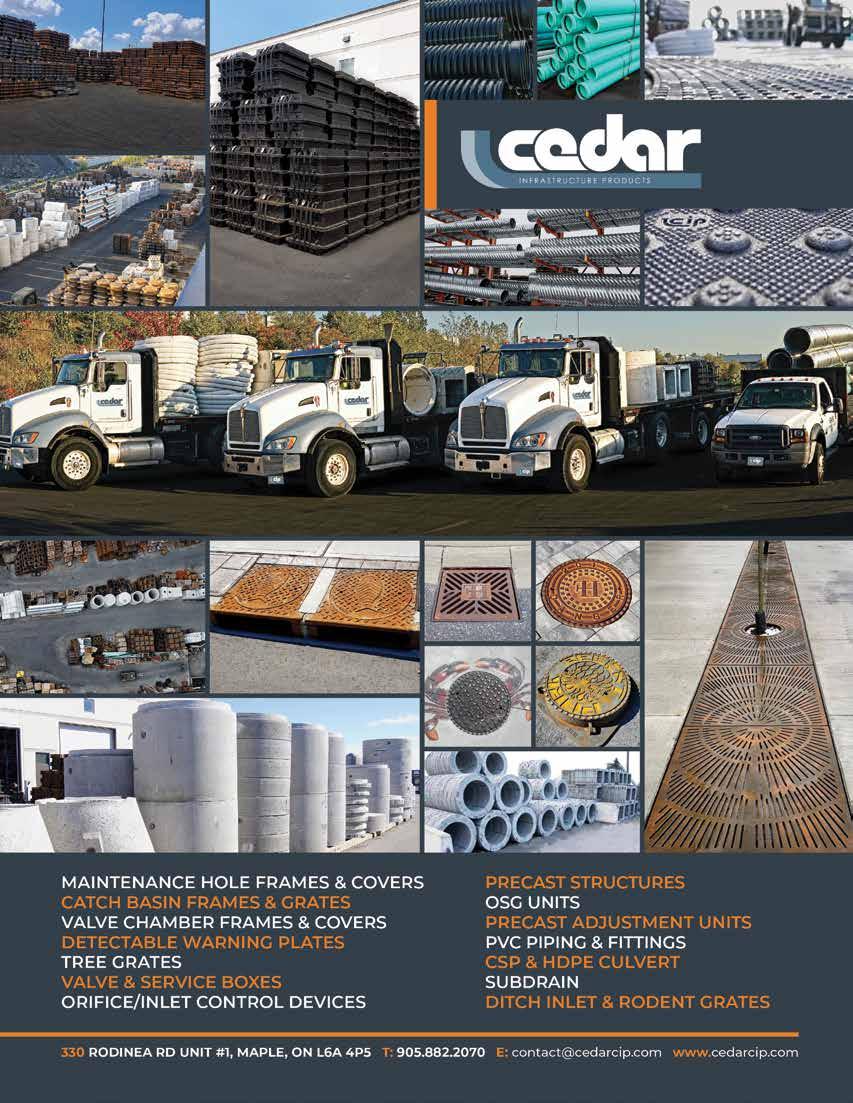
2022 ANNUAL MEMBERS’ GOLF TOURNAMENT












32 ORBA | ROADBUILDER
After a two year COVID-19 hiatus, the ORBA Annual Members’ Golf Tournament returned on August 17 at Station Creek golf course in Gormley. The event sold out in record time and brought out 302 golfers. Thank you to all those in attendance and to our sponsors. Congratulations to Tom O’Callaghan for recording a hole-in-one!













FALL 2022 33

ORBA Road Building Academy

The importance of continuing education and lifelong learning
Change in your career, change in your personal life, change in your community and organizations. One of the most effective ways of dealing with change is to continue gaining new knowledge. That’s why the Road Building Academy has become such an essential educational program for ORBA members.
Learning is essential to who we are as people. Seeking knowledge nourishes our minds. Lifelong learning is an indispensable tool for every career including the roadbuilding industry. Continuing education forms a necessary part in acquiring critical thinking skills and discovering new ways of relating to people from different cultures.
Education is your self-motivated persistence in acquiring expertise and competencies in order to expand your skill set and develop future opportunities. It forms part of your personal and professional development in an effort to avoid stagnation and help you reach your full potential. Through the Road Building Academy, knowledge is now at everyone’s fingertips.
Learning ensures that you won’t be left behind. It ensures that you remain relevant to your industry by keeping up-to-date with trends and adapting your skill set. To function effectively in this rapidly changing world of technology, you need to learn new things to remain valuable.
Continuing education will help you adapt to unexpected changes — for example, losing your job and having to depend on new skills to find work. By continuing to learn, you’ll be more comfortable to step out of your comfort zone and take on new job opportunities. When you’re always learning, you’ll keep improving and grow in your career and start to receive recommendations from colleagues and managers. The chances are that you’ll switch jobs multiple times throughout your life and you need to learn new skills to adapt accordingly.
For sixteen years, the Road Building Academy has brought worldclass instructors and courses from across North America to Ontario. The Academy has offered nearly 20 courses per year over the past three years, while adding new courses to keep the program fresh. Even COVID-19 could not stop it as ORBA was able to pivot and provide courses on-line. Academy courses cover management, leadership, business practice, technical & safety, and legal topics.
Once again, in 2023, the Road Building Academy will offer a certificate in Project Management I and Project Management II in conjunction with the University of Waterloo. The curriculum is compatible with the project management industry standard set by the Project Management Institute (PMI) and courses qualify for Professional Developments Units (PDUs)/Contact Hours.
FALL 2022 35
››
About the Canada-Ontario Job Grant Program
The Canada-Ontario Job Grant (COJG) provides opportunities for employers, individually or in groups, to invest in their workforce with help from the government. The COJG provides direct financial support to individual employers or employer consortia who wish to purchase training for their employees. It is available to small, medium and large businesses with a plan to deliver short-term training to existing and new employees.
Employers can receive up to $10,000 in government support per person for training costs. The training has to be delivered by an eligible, third-party trainer. Employers with 100 or more employees need to contribute 1/2 of the training costs. Small employers with less than 100 employees need to contribute 1/6 of training costs.
Currently the ministry is only accepting training applications for 25 or less participants. Employers interested in accessing funding to support training and/ or workforce development needs are encouraged to submit applications for Skills Development Fund (SDF).
For employer groups who want to apply for training support, the government offers a COJG Consortium Stream. The Consortium Stream allows a group of employers (two or more employers) to pool their resources to support common training objectives and goals. To apply as a consortium, the intermediary organization needs to ensure all the participating employers and trainees meet COJG requirements, and are able to make their required contribution towards the training cost.
If you’re an employer with a particular skills demand, the Canada-Ontario Job Grant might be right for you. Applications are accepted on an ongoing basis.
To learn more about the COJG visit their website at http://www.tcu.gov.on.ca/eng/eopg/cojg/. ORBA will be hosting COJG webinars in October and November on how to apply for the grants. Please watch your email inbox for more information.
Learning new things gives you a feeling of accomplishment, which in turn boosts your confidence in your own capabilities. Also, you’ll feel more ready to take on challenges and explore new business ventures.
Acquiring new skills will unveil new opportunities and help you find innovative solutions to problems. This could help you earn more money. Continuing education
opens your mind and changes your attitude by building on what you already know. The more you learn, the better you’ll get at seeing more sides of the same situation, helping you understand more deeply.
As an employer, providing support for continuing education shows employees that you see their value. This, in turn, effectively improves employee retention, which helps reduce expenses caused by employee turnover. Employees will feel more valued and motivated to expand their skills in different areas. A culture of ongoing learning benefits both current employees and recent hires, as well as attracting potential employees.
Companies considering registering their employees for Road Building Academy courses are encouraged to take advantage of the Canada-Ontario Job Grants Program which gives direct financial support for employee training. All ORBA Road Building Academy courses are eligible for funding.
 John Provenzano
John Provenzano
36 ORBA | ROADBUILDER

Sponsored Content · Sponsored Content · Sponsored Content · Sponsored Content · Sponsored Content
New workplace safety laws and the construction industry

Two new laws from the provincial government that were passed in the last several months will have a dramatic impact on the construction industry in Ontario. Bills 27 and 88, or the Working for Workers Act, 2021 and 2022, respectively, were recently passed into law and made significant changes to Ontario’s Employment Standards Act, 2000 (ESA), and the Occupational Health and Safety Act (OHSA).
The provincial government engaged in virtually no consultation with the business community, and in particular the construction industry, before passing the legislation.
These new laws focus on worker rights and protections. They offer no innovation, incentive or industry collaboration to improve worker safety in Ontario.
Bill 27, among other changes, adds the two following new provisions to the ESA:
• A requirement that Ontario employers with 25 or more employees have a written disconnecting from work policy by June 2, 2022; and
• A prohibition from entering into non-compete agreements with employees, retroactively from October 25, 2021, and onwards.
Bill 27 does not give workers an absolute right to disconnect from work; rather, it requires employers to establish a policy setting out their approach to disconnecting. An employer’s policy should be based on the unique needs of their business and industry.
The new prohibition against non-competition agreements would mean, for example, that a key estimator or superintendent can no longer be required to sign an employment contract that they will not ‘cross the street’ to a competitor. This may make the business vulnerable to the loss of top talent in a very competitive job market. The prohibition does have several exceptions for executives and when there is a sale of a business.
Under Bill 88, there are a number of critical changes that the construction industry should be aware of:
1. Employers will be required to provide naloxone kits to respond to a potential opioid overdose at their workplace. Kits must be present at the construction site if the employer becomes aware, or ought reasonably to be aware, that there may be a risk of a worker having an opioid overdose in their workplace. There must be a trained worker who has charge of the kit, who can identify the symptoms of an opioid overdose, and who can safely administer the naloxone. The date for implementation is still to be announced.
2. The OHSA was amended to increase the maximum financial penalty for officers and directors from $100,000 to $1,500,000, a 1,500 per cent increase , and up to 12 months in jail, or both.
38 ORBA | ROADBUILDER
3. The OHSA was also amended to increase the maximum penalty for a worker or supervisor from $100,000 to $500,000, a 500 per cent increase in addition to up to 12 months imprisonment.
4. The limitation period has doubled for commencing a prosecution under the OHSA from one year to two years. This new limitation period will take effect on July 1, 2022.
5. For the purpose of determining the penalty, the amended OHSA will now provide a non-exhaustive list of aggravating factors that may be taken into consideration by a court in sentencing convicted individuals and corporations.
We have a number of concerns regarding Bill 88. First, it is not clear why higher penalties are necessary or how they will result in safety improvements. Punishment after an accident does nothing to improve prevention. We are not aware of any evidence that the increase in fines in 2017 resulted in a material decrease in injuries or fatalities in workplaces across the province. The Ministry of Labour, Training and Skills Development (MLTSD) has not provided clear evidence of a safety gain to support these extraordinary increases in financial penalties to directors, officers, supervisors, and workers.

Second, the government’s decision to double the limitation period for the laying of charges is confusing and surprising. Most MLTSD investigations are completed within weeks or several months. By providing its inspectors with an additional year to lay charges, investigations may be extended, unreasonably placing additional stress and anxiety on construction industry supervisors and workers since they will not know whether or not they will be charged under
the OHSA for up to two years. This change will put further pressure on employers to retain legal counsel, conduct a privileged and confidential internal investigation following an incident, preserve evidence under the protection of that privilege, and get legal advice on preparing their due diligence defence. MLTSD inspectors who wait the full two years to lay charges, without reasonable explanation, may actually strengthen an accused’s argument that their rights under the Charter have been infringed.
Bill 27 and 88 give construction companies and business leaders greater legal responsibilities and risk of liability. It is more important than ever to establish an effective health and safety management system, obtain legal advice whenever an incident occurs that results in the MLTSD attending your workplace, and make safety legal risk management an ongoing priority for your business.
Norm Keith, L.L.M, is partner at KPMG Law LLP and is available for consultation, advice, and representation in all aspects of compliance with the OHSA and its regulations at nkeith@kpmg. ca or 416-476-2002 or 416-540-3435.
FALL 2022 39
Bill 27 and 88 give construction companies and business leaders greater legal responsibilities and risk of liability.
Inflation in the heavy civil construction industry
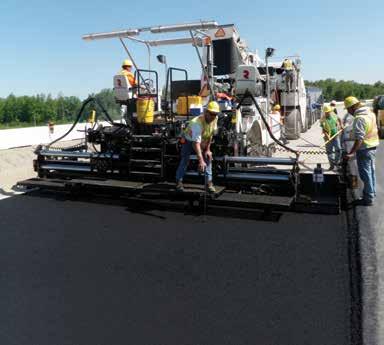


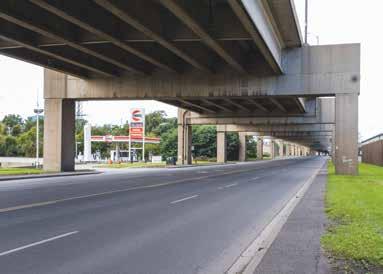 with Andrew Weltz
with Andrew Weltz
40 ORBA | ROADBUILDER
Heavy civil construction deals with materials like steel, concrete, and timber, all of which have been heavily impacted by inflation. Another inflationary issue has been the Buy American movement in the United States. Buy American has reduced competition in America and allowed a certain degree of profiteering on the part of the American steel industry. Canada is obviously tied to America in a number of ways, especially when it comes to supply. COVID-19 has also been a challenge because it has been harder to get vessels to ship material from overseas.
contract with the unions, you’re looking at double digit increases across the board. Labour is a huge component of our costs, accounting for 50 per cent of expenditures. If you add another 12 per cent in labour costs to a job, now the situation becomes almost untenable.
Q What is the role of ORBA during this time?
ORBA can help to facilitate discussions with MTO. As an association, we have a great platform for those discussions. I’ve been fortunate enough to be involved in a number of committees, like the Structures Committee and the Contracts and Documents Committee. ORBA has a voice that allows us to get in front of decision makers, especially in this discussion about inflation. I believe that you never develop a relationship when you need one; you develop it years in advance in order to have those relationships when you need them.
Supply chain is very interesting. One thing that gets glossed over is the war in Ukraine. Ukraine is not only the breadbasket of Europe, it’s also a big, big manufacturer of steel. They’re not supplying steel anymore and that means that North American prices have gone up because Ukraine isn’t able to ship or export. The war in Ukraine came out of nowhere for a lot of industries, and ours is no exception. Furthermore, the lack of steel is having an impact on completing jobs on time. Jobs that we tendered three months ago, that should be starting in the fall, may not have enough steel as suppliers are telling us that we might not be able to get the product until the spring of 2023.
Q Have labour costs increased as well?
Lack of skilled labour has been a problem for a number of years. I think what we’re seeing now is a big infrastructure build here in Ontario, with a spend of $56 billion in the next 10 years or so. Finding skilled people like carpenters, crane operators and heavy equipment operators has been a challenge. Furthermore, we’ll be going through union negotiations, and we can’t predict how this will affect wages. I suspect that increased wages at some point will not help inflation. When you’re negotiating a three-year
Q What can construction companies do to mitigate the affects of inflation?
Awarding sub-contracts quickly helps, because one of the challenges we’re facing when it comes to pricing is that steel prices are only good for the day. In reality, one thing I think is important is to communicate with partners on a regular basis. What I do with steel suppliers, even if it’s not for a specific job, is to keep in touch with them to keep my finger on the pulse of the industry to understand if there’s an increase coming. Also, having space available on site to store material is useful as well, because if there’s space available, you can always ship some of the material on site.
Andrew Weltz graduated with a degree in Civil Engineering from Dalhousie University. He is Vice-President, Eastern Canada for BAUER Foundations Canada Inc. Andrew is the second vicepresident on the ORBA Board of Directors and sits on the ORBA education, structures, and contracts and documents committees.
FALL 2022 41
Q How has inflation affected the heavy civil construction industry?
Q Have supply chain disruptions played a role in increased inflation?
Trillium Award program ensures asphalt plants are safe and environmentally sustainable

In 2002, OHMPA (now OAPC) created the Trillium Award program to provide member plant operators with a selfassessment checklist that goes above and beyond municipal and provincial standards. The self-assessment is based on strict operational, environmental, safety and community guidelines.
Our asphalt producers are responsible for keeping their plants esthetically pleasing, ensuring that silos are painted and display the Trillium Award logo. We encourage their locations to be landscaped and free of abandoned equipment and scrap. Plants should have a written plant operations manual and equipment should be repaired promptly if defects or excessive wear is detected. Plants are immediately disqualified from participating in the Trillium Awards if there are any visible emissions from the stack or other areas of the plant.
Plant environmental practices are of paramount importance. Plants must show that a spill prevention control and counter measurement plan is in place. Participating members are encouraged to have their environmental programs independently audited. With respect to safety, asphalt plants are expected to have a Certificate of Recognition (COR), which is an occupational health and safety accreditation program that verifies a fully implemented safety and health program which meets national
There are currently about 152 asphalt plants in Ontario, with 90 per cent of them being members of the Ontario Road Builders’ Association (ORBA) and the Ontario Asphalt Pavement Council (OAPC). Our members strive to be good neighbours by operating safe and environmentally sustainable plants in communities across the province.
42 ORBA | ROADBUILDER
visit www.onasphalt.org
standards. Our members are also encouraged to proactively communicate with community leaders and neighbours about changes in operations that may affect them directly. The plant should have a website where neighbourhood residents can get information about the plant. We also encourage members to host a tour or open house for neighbours, community groups and elected officials.
The Trillium Award program provides a guide to evaluate how our members’ operations measure up to the various criteria set up for them in the self-assessment. The award encourages them to exceed the standard requirements which also
resonates with OAPC’s culture of continuous improvement. The application checklist shows members what they are doing right and what they can do to improve operational standards at their locations. Providing members with a guide and checklist to follow helps them self-evaluate, ensuring that safety and environmental measures are in place, making them better community partners, and quality asphalt producers.
These opinion columns are excerpted from monthly columns published online through a partnership between ORBA and Metroland Media.

FALL 2022 43
To learn more about the OAPC Trillium Award program, please
Ontario is facing a lack of skilled workers

As a child, you may remember creating magnificent buildings, bridges and machines using LEGO, K’NEX or your Tinkertoy construction set. Then video games like Minecraft and SimCity taught you how to build a small town or a bustling metropolis.
Then, as a parent, you beamed with pride when your child proudly presented you with what they made using their imagination, ingenuity and most importantly, their own two hands. However, when it came to helping them choose a career path, the skilled trades or becoming a skilled worker never made the cut.
A new report from BuildForce Canada warns that the construction industry in Ontario will face a huge shortage of skilled workers over the next 10 years, and many construction projects will have trouble finding the workers they need. The biggest challenge facing employers in construction will be the shortage of skilled workers. In addition, more than one in five workers currently employed in construction will reach retirement age in those 10 years.
Replacing the thousands of retiring workers, as well as finding new workers to cope with expansion needs, will take about 110,000 new workers between now and 2024. The GTA will see the rollout of a large number of infrastructure projects, in addition to the expected new commercial and residential construction.
With the increasing job security and generous wages, why aren’t young people naturally gravitating towards these careers?
The reason might be that society has placed a stigma on skilled workers. As a result, young people are made to feel less of a person, often hearing they choose these careers because they can’t “make it” in university. Or, these careers are dead-end jobs that require back-breaking labour; or that skilled workers can only find lowpaying jobs that require long, hard work hours.
These statements are not entirely true. Skilled workers are required in highly skilled jobs requiring a mechanical aptitude many people don’t have. Far from being a job for those who are less capable, it takes a person with a unique skill set to meet the requirements of these demanding positions. Talk to someone who chose this career, and you will be surprised by the variety of jobs available.
Yes, the industry needs trade helpers, labourers, cement finishers and iron workers, but it also needs heavy equipment operators, construction estimators, construction managers and supervisors. Many people who like working with their hands continue to work hands-on jobs their whole lives, and those who put in the time can build a career and eventually move off the worksite and behind a desk if they choose.
Many skilled workers are not only paid well but have flexible schedules. For example, many individuals work eight or nine months of the year and can pursue other interests or travel during off-peak periods. In addition, many people start at a young age and learn on the job, earning money earlier, and their salaries often outpace those of their friends who first attend four years of university.
Let’s have an honest conversation with today’s youth about their career plans, and let’s not be afraid about talking about a career in the skilled trades or as a skilled worker.
These opinion columns are excerpted from monthly columns published online through a partnership between ORBA and Metroland Media.
44 ORBA | ROADBUILDER
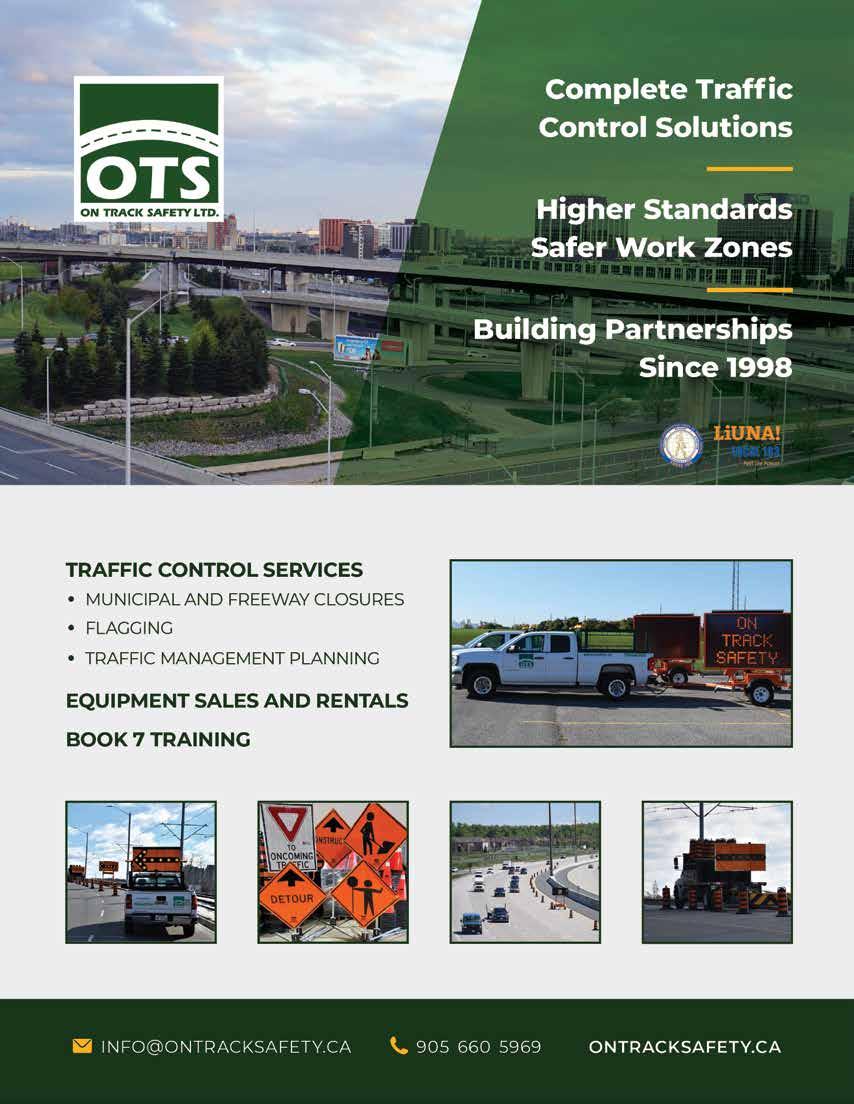
ORBA CORNER
ORBA Easter Seals Ontario
We are proud to continue our relationship with Easter Seals as our association’s charity of choice. Join us and many hockey legends on the ice for a day of fun. ORBA will have four teams playing in this year’s tournament from four regions across Ontario. Are you interested in joining a team, donating, or getting involved with Easter Seals? If so, please visit orba.org/hockey-classic or scan the QR code below.

ORBA Awards Nominations are Open

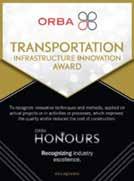



the ORBA Convention. To nominate an individual please, go to orba.org/awards or scan the QR code to learn more.



46 ORBA | ROADBUILDER
ORBA honours and recognizes individuals and member companies that demonstrate exemplary dedication and service to the association and the transportation infrastructure industry in Ontario. The recipients of these honours are recognized annually at
ORBA Road Building Academy ORBA Scholarships


If you know someone studying civil engineering at a post-secondary institution in Ontario, you should know that ORBA gives out four scholarships ranging from $2,000 to $3,000. Learn more at orba.org/scholarships or scan the QR code.

Do you want to stay ahead of the curve and develop your skills? Every year, the ORBA Road Building Academy brings world-class instructors to Ontario to put on a week-long academy that is perfect for professional development in the transportation infrastructure industry. Courses cover four critical areas: management and leadership, business and professional, technical and safety, and law and legal matters. This year we are back at the BMO Institute for Learning and will continue to offer specific online courses through Build Force. Make sure to visit orba.org/academy or scan the QR code and learn how you can upgrade your skills.

ORBA
FALL 2022 47 ORBA
• October
Celebrity Hockey Classics Series • November 03 - November 04, 2022 2022 ORBA President’s Tour • November 08, 2022 Sudbury • November 10, 2022 Ottawa • November 15, 2022 London • November 17, 2022 Toronto
CORNER
Fall Gala | The Roaring 1920s
15, 2022
SPOTLIGHT ON NEW MEMBERS!

COOPER EQUIPMENT RENTALS

Cooper Equipment Rentals is a full-service construction equipment rental company, servicing contractors across Canada. Cooper specializes in the rental of compact, aerial and heavy construction equipment while providing a wide range of supplies, along with unparalleled service and support. https://cooperequipment.ca/
DICOCCO CONTRACTORS INC.

Located in Sarnia, DiCocco Contractors Inc. specializes in general contracting, civil work, maintenance and turnarounds, and paving, water and wewage.
• Construction of roads/highways • Road maintenance • Sewer and water main • Culverts • Excavation • General contracting/heavy construction • Airports and golf courses www.dicoccocontractors.com
JADE EQUIPMENT COMPANY LTD.
Jade Equipment Company Ltd. specializes in parts, equipment sales and service, and rentals of heavy construction equipment. Jade Equipment, your grader expert, is the industry’s specialist for new, used and rebuilt parts for Volvo, Champion and John Deere motor graders. Jade Equipment also specializes in used reconditioned sales and rental (summer or winter) of motor graders, wheel loaders, excavators and more. Jade Equipment has a vast inventory of used and new attachments for your machines. www.jadeequipment.com

48 ORBA | ROADBUILDER
RENEW YOUR MEMBERSHIP TODAY! Joining ORBA is an investment in your company and in the future of road building. Get inside access to exclusive events, continuous education, sponsorships and exhibitions. Have an impact on government and contribute to a great industry.
MISKA TRAILER FACTORY

Since 1994, Miska Trailer Factory has grown to become the recognized leader in the utility trailer manufacturing industry. Miska Trailers continues its tradition by manufacturing superior quality utility trailers, at the most cost-effective price, using the most innovative designs. www.miskatrailers.com

NATT SAFETY SERVICES

NATT Safety Services supplies various safety training including Working at Heights, Confined Space, Mobile Elevated Work Platform and Rope Rescue among many others. Industrial training is offered to a diverse range of industries, from mining, pulp and paper, forestry, construction, and more. Industrial Services include safety consulting, rescue plan development, fit testing and more. www.nattsafety.com

FALL 2022 49
ABTECH www.abtech.cc/en 4
AIL INSURANCE www.ail.ca 25
ARTHUR J. GALLAGHER AJG.com/ca 8 AVIVA www.aviva.ca/gcs 35 CAPP www.capp.ca 37
CEDAR INFRASTRUCTURE www.cedarcip.com 31 CONEXPO www.conexpoconagg.com 16
D&A ROAD SERVICES INC. www.daroadservices.ca 11
HANDY HITCH MANUFACTURING www.handyhitch.com 29
INFRASTRUCTURE LOGISTICS www.infrastructurelogistics.ca 43
INTACT INSURANCE www.intact.ca 17
JADE EQUIPMENT COMPANY LTD. www.jadeequipment.com 19
LAFARGE CANADA INC. lafarge.com 46
LiUNA! ONTARIO PROVINCIAL DISTRICT COUNCIL www.liunaopdc.ca 20
MASTERS INSURANCE www.mastersinsurance.com 15
Mc ASPHALT INDUSTRIES LTD. www.mcasphalt.com 52
M&L TESTING EQUIPMENT www.mltest.com 38
NUCOR SKYLINE www.nucorskyline.com 9
ON TRACK SAFETY LTD. www.ontracksafety.ca 45
ONTARIO BARRIER WALL www.ontariobw.ca 7
PENINSULA CONSTRUCTION www.peninsula.ca 23
PLASTI-FAB plastifab.com 28
RAPCO rapcoequuipment.com 50 STINSON OWL-LITE www.stinson.ca 30

STRONGCO CORPORATION www.strongco.com 3
THE GEAR CENTRE www.gearcentre-offhwy.com 39
TOROMONT toromontcat.com/140-motor-grader 51
UPPER CANADA ROAD SERVICES INC. www.uppercanadaasphalt.com 21
VERDI ALLIANCE GROUP OF COMPANIES www.verdialliance.com 47
WALKER CONSTRUCTION walkerconstruction.ca 36 WIRTGEN AMERICA www.wirtgen-group.com 2
YELLOWLINE ASPHALT PRODUCTS LTD. www.yellowline.ca 49
50 ORBA | ROADBUILDER
















 Director, Policy and Stakeholder Relations
ANDREW HURD
Director, Policy and Stakeholder Relations
ANDREW HURD



















 Lara Henry is a communication specialist and editor of ROADBuilder.
Lara Henry is a communication specialist and editor of ROADBuilder.

































 John Provenzano
John Provenzano






 with Andrew Weltz
with Andrew Weltz
































